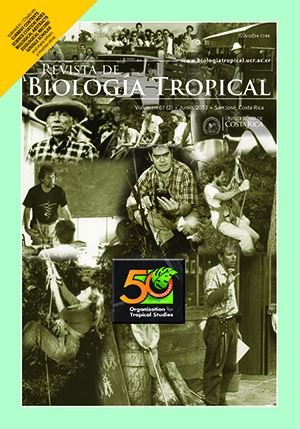Abstract
Champotón River is an unknown area within the Mesoamerican hotspot in Southestern México. Reproductive traits and population structure of Astyanax aeneus were analyzed along an environmental gradient of the upper, middle and lower sections of the river, where diverse environmental factors were recorded. For this, nets were cast for 1h at each site and A. aeneus were collected from all sections with sweep nets (5 and 10m long by 5m deep, 0.03m mesh size) and a casting net (0.05m mesh size). At each study site and campaign, a total of 80 specimens (in average) were collected and were fixed in 10% formaldehyde for further analysis. Population structure by size was analyzed for each study site, based on the relative frequencies by standard length classes. The length-weight relationship was determined, and the identification of gonadal developmental stages, reproductive period, size at first sexual maturity, relative fecundity, sex ratio and somatic indexes (gonadosomatic, hepatosomatic and Fulton’s condition factor) were also assessed. Seven size classes were found in the upper and middle sections, and nine downstream, with seasonal and spatial pattern in size-class frequency distribution. Size at first maturity was 45.7mm for females and 40.8mm for males. The maximum relative fecundity was recorded at the downstream site and was positively correlated with body weight and standard length. Sex ratio (1.8:1 males: females) differed significantly from expected values (1:1). Gonadosomatic index scores indicated that the reproductive period of this species in the Champotón River was from April to July, during the warm and wet season. Hepatosomatic index was negatively correlated with the Gonadosomatic index, evidencing transfer of energy from the liver towards gamete production. This strategy enabled A. aeneus to maintain robustness during the study period with tiny changes in condition factor. A. aeneus in the Champotón River, as opposed to South American river congeneric species of similar size, shows early sexual maturity, a short reproductive period with high gonadosomatic index values, and high fecundity, a trade-off for the short reproductive period. Spatio-temporal segregation was evident: breeders congregate downstream, while juveniles prefer the upper reaches. This pattern allows A. aenus to be successful in a river with high frequency of hurricanes.##plugins.facebook.comentarios##
Downloads
Download data is not yet available.






